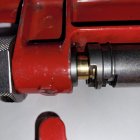Hey thats an interesting idea!
.257Roberts -
Howdy !
While I believe the use of a Hornady bushing NS die would be t he easiest route' to go for your .219 Donaldson use,I finally had a little time to review terminology use for the Lee " Collet Neck Size Dies ".
So, I'll include some info about impressing a LEE .220Swift Collet NS die into use for the Donaldson.
Lee uses around 4 different threaded outer die bodies. The die bodies accept the inner " collet ", " sleeve "; and upper threaded aluminum cap. The die bodies feature an inside lower lip just above the their entrance, that works in-conjunction w/ a mating " step " on the outside of the die's " sleeve "; to keep the inner collet from falling out the bottom of the die.
Lee provides different " collets " for individual cases. The collets have 4 intregral " petals " cut into them.
These petals close in spacing when the collet is advance up-into the upper mating " sleeve ". The " collets " have a " step " on their outer surface, that works in-conjunction w/ a mating lip inside the lower entrance of the die; that keeps the " collet " from falling out the bottom of the die.
The dies have different diameter mandrels, that are surface the collet squeezes the case' necks against;
to provide the desired neck sizing action.
The collet dies feature different " sleeves " dedicated to each individual case.
The sleeve is located above the collet, and has a bevelled entrance @ the lower end that accepts the upper tapered outside surface of the collet. * The sleeve is what ( to a large degree ) dictates what calibre of mandrel can be accepted. The sleeve's center hole is intended to keep the mandrel centered in the die.
For these reasons.... an ( example ) " .22-250 " sleeve center hole won't accept a larger diam ( example ) .308Win mandrel.
When using the collet NS die.... operating the press handle advances the case to be sized up-into the die.
The inner sleeve is allowed some room to move upward during use, until it reaches a stopping point, dictated by the prescence of the threaded die cap. The cap also features and inner circular clearance on its lower surface, that accepts the cirular upper " head " on the mandrel. This head is necessary to keep mandrels from falling out the bottom of the die.
By design, the lower end of the collet contacts the shell holder, and the collet's upper petals close down on the case' neck, squeezing it against the mandrel as the tapered collet upper surface advances up-into the bevelled entrance of the sleeve. Lee provides mandrels that allow .002" " squeeze on case' necks. They used to offer to reduce their mandrels an additional .001", for a nominal fee. I DK if LEE currently offers that service ? However, one can always reduce mandrel OD themsleves, if need be.
As stated before.... for neck sizing the .219 Donaldson using a collet die, you could use a .220 Swift collet die body & lock ring, retaining the inner .220 Swift collet.... and also keeping the dedicated .220 Swift sleeve; and of course.... the universal upper cap.
* The ' Swift die's collet inner diameter are generous enough to accept the slightly larger shoulder diam of the .219 Donaldson case, which from what I've read might run around .005" greater diam.
While the Swift case' rim face-to-shoulder dimension is some .410" longer than the rim face-to-shoulder dimension seen on the Donaldson, this can be accomodated by trimming off part of the lower collet that protrudes out the bottom of the die.... and by use of a washer or bushing to enusre the collet can be advanced sufficiently up-into the die for proper sizing action. Another key part of this, would be to use a
" perch " along w/ the die. A " perch " is a shell holder that has a 1/4-20 flat head shoulder bolt placed through the center or the washer.... the bolt head trapping the washer between the bolt head and the shell holder. The bolt's threads pass through the primer ram slot of the shell holder. The bolt can simply be epoxied in place.
* The perch allows the case to be advanced further up-into the die than the limit of travel that contact w/ the shell holder would customarily produce. The shoulder bolt I used for my " perch " results in a .200" gap between bottom of the bolt head and the flat surface of the primer entrance slot in the shell holder.
That .200" gap + the amount of metal removed from the bottom of the collet together should serve to make up the .410" difference in case dimension; noted above.
I added a properly sized helical spring inside the die, between the cap and the top of the sleeve.
The idea being that the spring would return the die to " battery " ( the starting position of the die in the sizing process ). This was necessary since .... when using a perch... the case simply sits atop it. There is no case holder to " pull " the case back out of the die. When the die goes back to battery.... the sized case is made available for manual extraction from the mandrel.
Lastly, I will add that I went the LEE route' when assembling a customized die for use in neck sizing
6.8 SPC. Of course, the only .277" cal Lee Collet NS die is the one they make for .270 Win.
We used the methods described above, and they worked.... even though the .270Win case is a lot longer than what the 6.8SPC case is.
Hope this helps.
With regards,
357Mag












